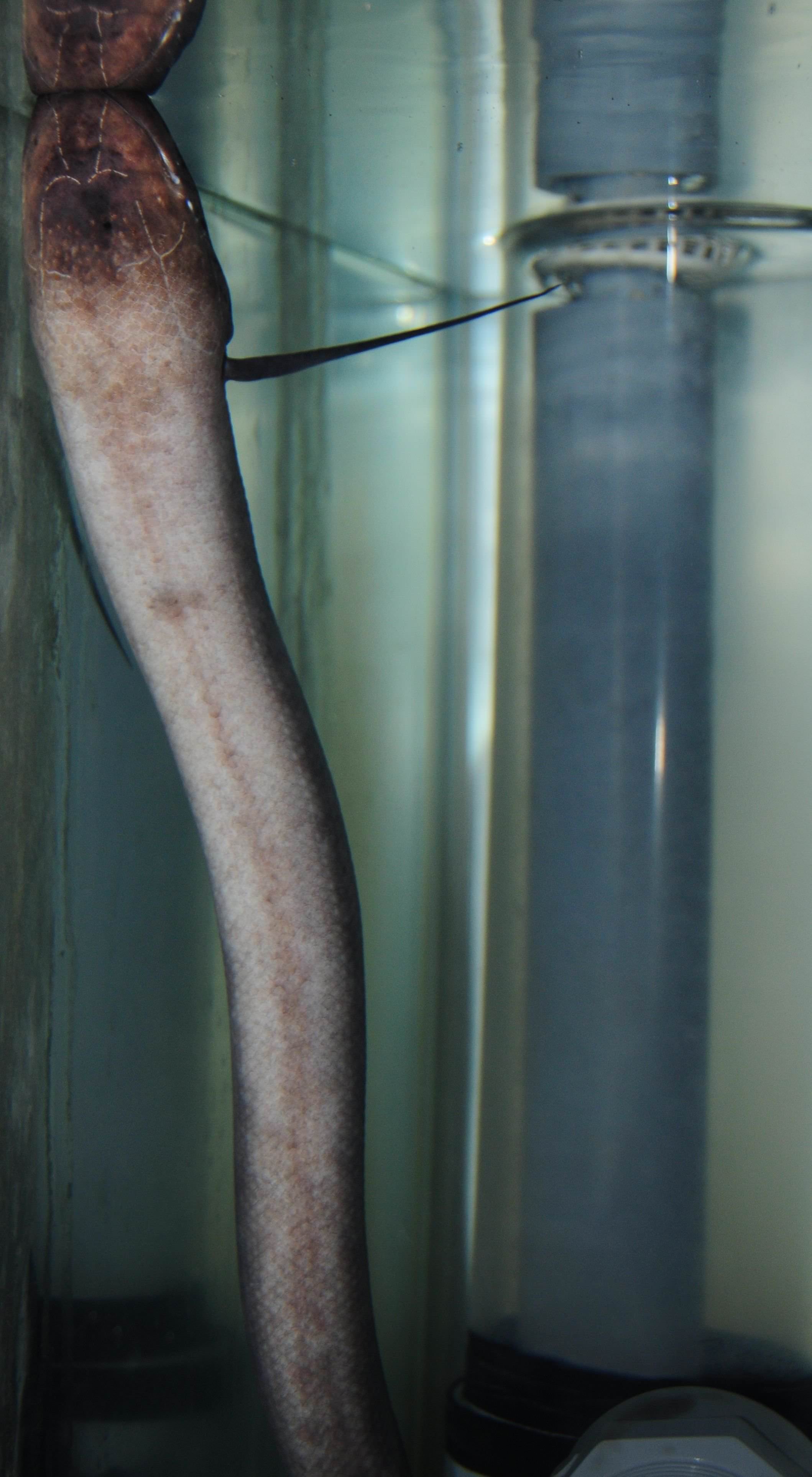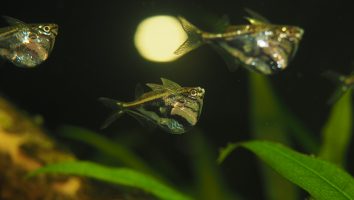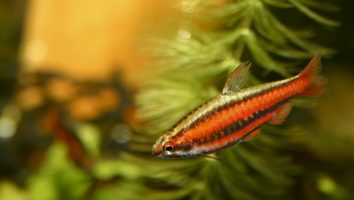The Spotted lungfish is a stunning freshwater fish that is native to Africa. These fish are not commonly kept as pets, but they are becoming more popular in the aquarium trade.
If you are thinking about getting a Spotted lungfish, then you need to read this guide. We will go over everything you need to know about Spotted lungfish care. From diet and tank size, to lifespan and tank mates.
Table of contents
Species overview
Spotted lungfish (scientific name: Protopterus dolloi) are a type of air-breathing freshwater fish that is native to the Congo River Basin in Africa.
They are one of the largest freshwater fish in the world and can grow to be up to 10 feet in length!
Spotted lungfish are very unique fish and have a number of features that set them apart from other fish species. For one, they have a pair of lungs in addition to gills, which allows them to survive in water with very low oxygen levels.
They are also able to survive out of water for long periods of time by aestivating (burrowing into the mud and essentially going into a state of hibernation).
Due to their unique features and large size, spotted lungfish are not a common choice for most aquariums. However, they are popular among fish enthusiasts and are definitely an interesting fish to keep!
Appearance

The Spotted lungfish is a very large and curious-looking creature. These fish can grow up to 6 feet in length, making them one of the largest freshwater fish in the world.
The bodies of these fish are long, slender, and eel-like with a small head. They have a pair of small pectoral fins near their head and a larger dorsal fin further back.
Their caudal fin is large and paddle-like, which helps them move through the water. They also have a pair of small pelvic fins near their ventral (belly) side.
The most notable feature of the Spotted lungfish is the large “lung” on their ventral side. This is used to help them breathe in low-oxygen environments.
The skin of the Spotted lungfish is smooth with a layer of mucus. They are usually a brown, gray, or black color with spots that can be white, yellow, or cream-colored.
Lifespan
In the wild, the average lifespan of a spotted lungfish is unknown. In captivity, they can live for decades—the oldest recorded spotted lungfish was 56 years old!
While their long lifespan is certainly impressive, it’s important to keep in mind that these fish have very specific care requirements. Without the proper environment, they will not thrive (or live nearly as long).
Size
The average Spotted lungfish size is around 4 feet, but they can grow to be up to 6 feet long! These massive freshwater fish are some of the largest in the world and can weigh up to 100 pounds.
Tank
Tank Size
The recommended minimum tank size for a spotted lungfish is 125 gallons. This is a very large and active fish that needs plenty of room to move around. It’s also a messy fish that produces a lot of waste, so a large and well-filtered tank is a must.
Water Parameters
Spotted lungfish are a bit more challenging to care for than some of the other fish on this list. They come from Africa and prefer murky, stagnant water with very little flow.
This can make things difficult when trying to maintain water quality in the aquarium. It’s important to do regular water changes and to use a good filter.
You should also be aware of the potential for parasites. These fish are often wild-caught and may not have been treated for parasites before being imported. It’s always a good idea to treat new fish before adding them to your aquarium.
Here are a few guidelines for keeping spotted lungfish healthy and happy.
- Water temperature: 73 to 82 degrees Fahrenheit
- pH levels: 6.5 to 7.5
- Water hardness: 4 to 15 dGH
- Alkalinity Levels: 3-8 dKH
What To Put In Their Tank
Spotted lungfish are not a very demanding species when it comes to the inside of their tank.
A lot of the time you’ll see these fish kept in tanks with very little decoration. This is perfectly fine and they will do just fine without a lot of frills.
That being said, we still recommend including some basic decorations. Driftwood, rocks, and plants are all great choices.
The plants you include don’t need to be anything special. Hornwort, water wisteria, and java moss are all great options.
For the substrate, these fish don’t have any specific needs. You can use gravel, sand, or a mix of the two. Just avoid anything too sharp or jagged.
Common Diseases
Spotted lungfish are a hardy species of fish, but that doesn’t mean they can’t get sick. There are a few diseases that these fish are particularly susceptible to.
The most common is Hole in the Head Disease. This disease gets its name from the pits that form in the fish’s skin, usually around the head area.
This disease is caused by poor water quality and the presence of activated carbon in the tank. The best way to treat it is to improve the water quality and remove the activated carbon.
The other disease that these fish are prone to is Ich. This is a parasites that affects freshwater fish of all kinds, not just lungfish.
The most obvious symptom of Ich is the presence of white spots on the body of the fish. If you notice this, it’s important to act fast and consult a vet.
There are plenty of other potential diseases that these fish can get, but these are the most common. By keeping a close eye on your fish and maintaining a clean and stable habitat, you can help prevent them from getting sick.
Behavior & Temperament
Spotted lungfish are not the most active fish in the world. They’re relatively sedentary, only moving when they need to. Even when they do move, it’s not with a lot of urgency.
This low activity level is likely due to the fact that they don’t need to move much to get the food they need. In the wild, these fish lie in wait for their prey. When an unsuspecting victim comes by, the lungfish will snatch it up and consume it.
This same behavior can be seen in aquariums. Spotted lungfish don’t swim around looking for food. Instead, they remain relatively stationary and wait for food to come to them.
They’re not aggressive fish, but they will eat anything that fits in their mouths. This includes smaller fish, so it’s best to keep them with fish that are too large to be considered food.
Tank Mates
Spotted lungfish are best kept alone or in pairs. They’re not an especially social fish and don’t do well in groups.
They can be territorial with their own kind as well. If you do decide to keep more than one, make sure you have a large enough tank. A 125-gallon aquarium is a good starting point.
As for other tank mates, there aren’t many options. These fish are large and need a lot of space. They’re also slow-moving, which makes them an easy target for predators.
The only other fish that can really work is another lungfish. But even then, you’re pushing it. It’s best to stick with just one or two of these fish in a tank.
Breeding
The spotted lungfish is a bit of an enigma when it comes to breeding in captivity. There have been reports of success, but it’s still considered to be quite difficult.
These fish are very particular when it comes to their spawning environment. They need still water with a high oxygen content. That’s why most breeders use a special chamber that’s connected to an oxygenated tank.
The chamber is usually filled with clay pellets. That’s where the female will lay her eggs. After she does that, the male will come in and fertilize them.
The eggs will hatch in about two weeks. The fry will spend the next few months in the chamber before they’re large enough to move to a regular tank.
Feeding the fry can be a challenge. They need to eat small insects and other invertebrates. Some breeders use a special diet of live foods, while others raise their own insects.
Conclusion
The Spotted Lungfish is a great fish for the beginning aquarist. They’re relatively hardy, can adapt to a wide range of water conditions, and are relatively peaceful.
They are, however, on the large side so you’ll need to have a tank that can accommodate them.
Overall, we think the Spotted Lungfish is a great choice for anyone looking for a new fish for their tank.












